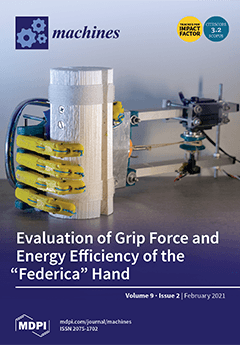Open AccessEditor’s ChoiceArticle
Evaluation of Grip Force and Energy Efficiency of the “Federica” Hand
by
Daniele Esposito, Sergio Savino, Chiara Cosenza, Emilio Andreozzi, Gaetano Dario Gargiulo, Caitlin Polley, Giuseppe Cesarelli, Giovanni D’Addio and Paolo Bifulco
Cited by 28 | Viewed by 6478
Abstract
The actual grip force provided by a hand prosthesis is an important parameter to evaluate its efficiency. To this end, a split cylindrical handlebar embedding a single-axis load cell was designed, 3D printed and assembled. Various measurements were made to evaluate the performances
[...] Read more.
The actual grip force provided by a hand prosthesis is an important parameter to evaluate its efficiency. To this end, a split cylindrical handlebar embedding a single-axis load cell was designed, 3D printed and assembled. Various measurements were made to evaluate the performances of the “Federica” hand, a simple low-cost hand prosthesis. The handlebar was placed at different angular positions with respect to the hand palm, and the experimental data were processed to estimate the overall grip force. In addition, piezoresistive force sensors were applied on selected phalanxes of the prosthesis, in order to map the distribution of the grasping forces between them. The electrical current supplied to the single servomotor that actuates all the five fingers, was monitored to estimate the force exerted on the main actuator tendon, while tendon displacement was evaluated by a rotary potentiometer fixed to the servomotor shaft. The force transfer ratio of the whole system was about 12.85 %, and the mean dissipated energy for a complete cycle of closing-opening was 106.80 Nmm, resulting lower than that of many commercial prostheses. The mean grip force of the “Federica” hand was 8.80 N, that is enough to support the user in many actions of daily life, also considering the adaptive wrapping capability of the prosthesis. On average, the middle phalanges exerted the greatest grip force (2.65 N) on the handlebar, while the distal phalanges a force of 1.66 N.
Full article
►▼
Show Figures





